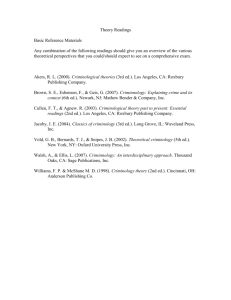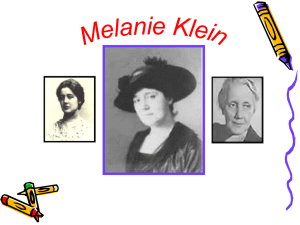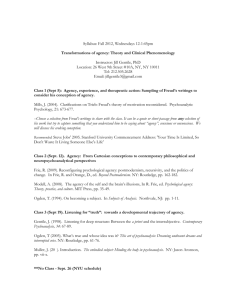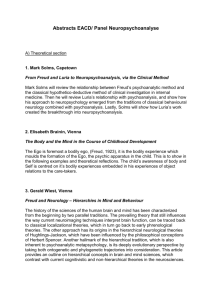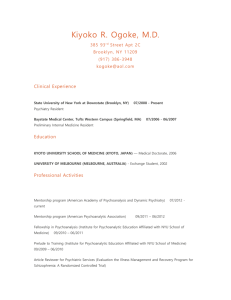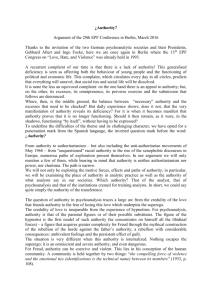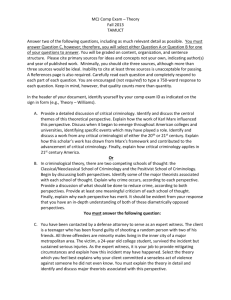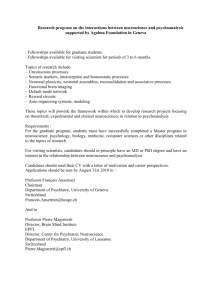The Re-emergence of Psychoanalytical Criminology
advertisement
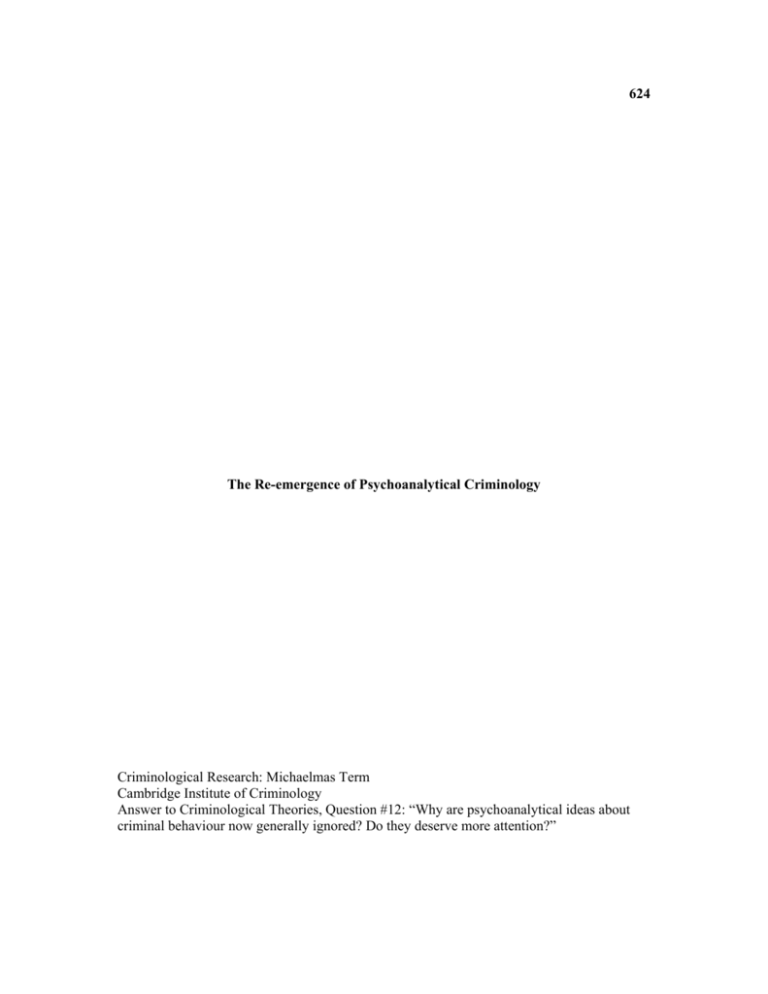
624 The Re-emergence of Psychoanalytical Criminology Criminological Research: Michaelmas Term Cambridge Institute of Criminology Answer to Criminological Theories, Question #12: “Why are psychoanalytical ideas about criminal behaviour now generally ignored? Do they deserve more attention?” Writing near the end of his life, Sigmund Freud advanced the claim that psychology ought “to take its place as a natural science like any other,” and that “psychoanalysis is part of the mental science of psychology…Psychology, too, is a natural science. What else can it be?” (Freud 1953, 23: 158, 282). For many decades, Freud’s theories enjoyed a widespread acceptance in the fields of psychology and criminology; indeed, psychoanalysis became the dominant paradigm. Its legitimacy began to erode, however, as a variety of theoretical and methodological competitors came onto the scene. Positivists assailed psychoanalysis for employing a methodology which was both empirically unverifiable and vulnerable to subjective misinterpretation. Other major criminological camps, including left idealism, left realism, administrative criminology, right realism, feminist criminology, criticized the psychoanalytic approach to criminology. By the last decades of the twentieth century, psychoanalysis had become an object of ridicule to both academics and clinicians. Yet in the last decade, criminologists and forensic psychotherapists have reinvigorated psychoanalytical readings of a variety of issues, such as criminal motivation, fear of crime, and the act of punishment. Psychoanalytical criminology has weathered a number of theoretical, methodological, and practical challenges, and is now emerging from a long period of decline as a legitimate and mainstream criminological approach. In 1900, Freud published The Interpretation of Dreams and ushered in an century of theorists and clinicians attuned to the unconscious inner workings of the human mind. Freud continued to publish until his death in 1939; thereafter psychoanalytic thought flourished through the work of Carl Jung, Alfred Alder, James Lacan, Erich Fromm and a host of other notables. The discipline found footholds in a variety of social science disciplines, including the nascent field of criminology. In 1916 Freud published a short analysis entitled ‘Criminality from a Sense of Guilt,’ in which he maintains that crime is committed by individuals with tremendous unconscious guilt and overdeveloped superegos who seek to be caught and punished. This vague postulation never matured into a fully formed theory of crime, but the notion was picked up by a number of neo-Freudians such as August Aichhorn and Melanie Klein in the 1920s, and Fritz Redl and David Wineman in the 1950s. Child psychologist Melanie Klein published ‘Criminal Tendencies in Normal Children,’ followed 1 closely by ‘On Criminality,’ in which she argues that it is not the “weakness or lack of a super-ego,” but the “overpowering strictness of the super-ego” which is responsible for criminal behaviour (Klein 1934: 258). This early theory of crime was in the ascendancy for many decades during which psychoanalysis enjoyed a heyday as the authoritative theory of psychology. Despite the overarching success of psychoanalysis, it had its detractors. British psychoanalyst Edward Glover remarks that in the period following the First World War, psychoanalysts were regarded as “more than a little peculiar.” (Glover 1960: 3). In another instance, a psychoanalyst delivered a lecture to a room of magistrate judges in 1922. Observing the frosty reception, Glover remarked that “it is scarcely to be expected that psychology and the Law should always see eye to eye” (Glover 1960: 5). Amongst psychiatrists, the rise of a biological approach precipitated the decline of psychoanalysis, which fell out of favour with the psychological academy, the pharmaceutical industry, medical insurers. Psychoanalysts were caricatured as cold, distant, narcissistic disciples of Freud with a thinly veiled penchant for perversion. Criminologists and other social scientists criticized psychoanalysis’s lack of empirical verification, its inconsistent application in clinical settings, and its theoretical immaturity. David Garland states “unfortunately such psychoanalytical literature as there is on this topic is often analytically crude and unpersuasive.” (Garland 1990: 240). British psychoanalyst Edward Glover tracked the growth of psychoanalysis in the first half of the twentieth century. He also noted its growing pains, including theoretical fragmentation and the scarcity of properly trained psychoanalysts. By 1948, observing the splintering of the psychoanalysis practitioners into Freudians, Jungians and Alderians, Glover bemoans the fragmentation between these schools and the consequent eclecticism among practitioners. He criticizes the application of a “compost of theories and methods,” and further remarks: “Indeed at the present rate of diffusion of clinical theories, it would seem that for some time ahead such psychiatric and child guidance centres as are not run by formal psychiatrists will fall under the direction of eclectics, a state of affairs which bodes ill for any radical progress in research” (Glover 1960: 43). Ironically, Glover himself contributed to the fragmentation of psychoanalysis: he engaged in a series of notorious internecine disputes 2 with the Kleinians in the United Kingdom, thereby embroiling a cross-Atlantic controversy and earning the support of psychoanalysts in the United States. Addressing the lack of clinical and sociological research, Glover estimated that the number of qualified psychoanalytic criminologists in the United Kingdom “can be counted on the fingers of two hands” (Glover 1960: 43). In a searing indictment of half-baked psychoanalytical methods, Glover writes: “A good deal of this interference, although not exactly bogus, is based on a remarkable and rather smug over-estimation of the virtues of pseudo-analytical therapy. It is hard enough for a trained analyst applying his elaborate and lengthy techniques to the treatment of selected favourable cases, to obtain satisfactory results. What happens when half-boiled social workers, half-trained in analytical techniques, apply them indiscriminately in the delicate task of social guidance can but be left to the imagination” (Glover 1960, 67; writing in 1955). He guessed the number of qualified clinical practitioners in Great Britain at only a “few dozen,” and gave “a sanguine estimate” that of these, only two-thirds were capable of administering a psychoanalytical course of treatment through to conclusion (Glover 1960: 4344). One of the reasons for the decline of psychoanalysis was the vast expense required for psychoanalytical training, treatment and research. The subsequent proliferation of “pseudoanalytical” therapists hastened psychoanalysis’s slide into disrepute. Criminology’s early marriage with psychoanalysis began to fray. Garland observes that it is no wonder that the key criminological texts from the early part of the twentieth century adopted a psychoanalytic approach, as most criminological authors from this period were practitioners working in the penal system. Recent commentator Elaine Player observes that “until World War II criminology in Britain was dominated by a medic-psychological model which concentrated upon the pathology of the individual offender and was specifically directed towards the development of a correctionalist penal policy” (Player 1996, 82). Unfortunately, the theoretical rigidity of psychoanalysis helped to bring about its downfall, as psychoanalysts made overreaching and bizarre claims. For example, Klein makes the sweeping claim that, “[p]sychoanalysis has shown that the Oedipus complex plays the largest part in the entire development of a personality…[and] that all shades of difficulties of character, from the slightly neurotic to the criminalistic, are determined by it.” (Klein 1927:171, emphasis added). Another example is the phallic obsession: Glover offers a case history of a girl who stole cucumbers and pencils “with colored butts,” which he interpreted 3 as a symbolic theft of her baby brother’s penis (Glover 1960: 14-15). Critics of psychoanalysis did not have to look far for fodder, and soon Freud’s approach was widely dismissed as Viennese quackery. Criminology turned in the direction of positivism and its Enlightenment history. The research psychologist and behaviourist Hans Eysenck once remarked: “we can no more test Freudian hypotheses ‘on the couch’ than we can adjudicate between the rival hypotheses of Newton and Einstein by going to sleep under an apple tree” (Grünbaum 1984: 97).1 For the sake of this paper, the term “positivist critique” will refer to the scientific, behaviourist, and administrative criticisms of psychoanalysis, as summarised in the following arguments. Psychoanalytic theory posits that the individual is at the mercy of irrational and unseen forces, but criminal behaviour is better explained through the model of the wilful rational actor. Psychoanalysis focuses on individual pathology, but provides no prescription for how the state should manage the larger community problems of crime. Psychoanalytical methodology is empirically unverifiable, and is grossly over-reliant on the highly intersubjective interpretation of the psychoanalyst. Furthermore, when asked to present proof, psychoanalysts make the tautological claim that the proof of psychological disturbance is the crime itself, and that the crime was precipitated by psychological disturbance. Swayed by these arguments and others, policy makers adopted a positivist evaluation rubric, and soon governmental funding began to dry up for a psychoanalytic approach that failed bureaucratic metrics. Psychoanalysts, for their part, did little to refute the positivist critique. Decades earlier, Klein made the following dubious claim: “it is not possible within the limits of this paper to enter more fully into the details of my technique. I must confine myself to the statement that I get this material in so many different performances and in such variety that an error about its meaning is impossible; which is proved, too, through the resolving and liberating effect of the interpretations” (Klein 1927: 174). This ‘proof’ failed to sway Klein’s positivist critics. Glover can be criticized for making exaggerated claims of psychoanalysis’s success in praxis. For example, he claims that in cases of delinquency, of those properly treated, ninety percent become non-delinquent (Glover 1960: 53). These sorts of 1 Quoting Hans Eysenck (1963). Uses and Abuses of Psychology. Baltimore: Penguin. 4 unsubstantiated psychoanalytical claims cast doubt on the efficacy of the psychoanalytic approach to crime. Besides the positivist critique, psychoanalysis was also deemed incompatible with the reigning criminological camps, including left idealism, left realism, administrative criminology, right realism, feminist criminology. Although there is not space in this paper for a thorough examination, let us briefly survey each of these camps. First, left idealism holds that systems of criminal justice serve the dominant social order and target the less privileged. It locates forensic psychotherapy within the structure of manipulative state control. However, a psychodynamic approach might be incorporated as “to provide offenders with insight into their own behaviour, and how it relates to their position in the social order, and thereby serve as a consciousness raising exercise which would foment political pressure for social change” (Player 1996, 84-5). Left realist criminologists object to the individual pathologisation of psychoanalysis. They argue that crime is not biologically determined but rather socially constructed by society’s reaction to those biological determinants. Individual pathologisation may blind the offender to the larger social context of his or her situation. Another major camp of criminology, broadly termed ‘administrative criminology’ is the current dominant paradigm, and enjoys support by the Home Office. It models the offender as a rational actor and requires empirical evidence, which early positivism lacked. Administrative criminology and psychoanalysis are at odds in that the former’s strict empiricism cannot be reconciled with the latter’s reliance on case studies, clinical experience, and empirically untestable hypotheses. Right realism, popular in the United States, focuses on child-rearing and advocates a limited therapeutic approach for at-risk populations, especially youth. It adopts a behavioural conditioning approach which is at loggerheads with a psychotherapeutic approach, and the criterion for evaluation of psychotherapeutic programmes would be to demonstrate their contribution to a reduction in crime. Finally, some of the most incisive critiques of Freudian psychoanalysis come from feminist writers who lambaste its patriarchal obsession with the penis. However, gender theory has adopted many psychoanalytical assumptions about the mind and the formation of identity. At first blush, the criminological camps (left idealism, left realism, administrative criminology, right realism, feminist criminology) seem incompatible with psychoanalysis, but it may be possible to find common ground. Recent 5 proponents of psychoanalysis have attempted a reconciliation, by incorporating psychoanalytical approaches into the mainstream approaches to criminology. For decades, the combined critique of positivism and the criminological camps caused a decline in the mainstream application of psychoanalysis. But rumours of the death of psychoanalysis have been greatly exaggerated. After decades of the domination of a quantitative, rationalist approach to criminology, a new psychoanalysis has emerged from the shadows to question the epistemological relevance of positivism and to provide a more thorough defence of psychoanalytic methods. For example, psychologist Wendy Hollway has criticized positivist methodology for failing to explicate the complex and sometimes irrational workings of the human mind. In her work on society’s fear of crime, she points out that Likert scales and other traditional quantitative survey methods suffer from a variety of shortcomings, including a reductivist definition of the fear of crime and a reliance on the ability of subjects to accurately self-report. Positivist methodology limits the collection of data to discrete and easily quantifiable information. Positivists fail to problematise their research questions, and avoid dealing with data that is not operationalisable. In the field of psychology, ‘evidence-based practice’ is the dominant approach, which Hollway assails as part of positivistic science’s misguided appropriation of the legitimate forms of knowledge. It “implies that practice was not based on evidence before” (Hollway 2001: 9-10). Hollway gives an excellent example of the theoretical, methodological, and evaluational limitations inherent to a positivist approach. She cites an example of a probation officer or clinical psychologist who has been trained in cognitive behavioural therapy, “because research has shown that it is more effective than other kinds of interventions. (It is also likely to be shorter and cheaper.) This ‘evidence’ derives from a paradigm which is compatible with the precepts of dominant research methodology. It isolates clients from their contexts, positions the therapist outside the phenomenon being changed (the “individual”), reproduces a mechanistic and rationalist view of behaviour change which ignores affective states and their part in meaning and action…Criteria for what constitutes success are limited to what is operationalisable and measurable. Not surprisingly, psychoanalytic therapy, for example, does not fare well when subjected to such paradigms of evidence…” (Hollway 2001: 11-12). Hollway’s arguments here may explain why psychoanalysis fell into disrepute. It is not that psychoanalysis is an ineffectual approach, but that the evaluation of psychoanalysis is based upon a paradigm that fails to recognize the contours of intersubjective meaning. 6 Traditional psychoanalytic techniques such as free association and interpretation have resurfaced in clinical practice. Free association can be viewed as an alternative qualitative methodology which follows a narrative track, and which may expose contradictions or avoidance mechanisms otherwise undetected. These in-depth techniques, when applied to a few individuals, often get closer to the heart of the matter than a survey which canvasses a thousand individuals but only scratches the surface of their experiences. The shallow data collected by quantitative data methods may meet statistical requirements, but may also represent merely the macro epiphenomenon of a deeper current. Additionally, the psychoanalytical critique of the dominant paradigm questions the meaning of language and human intersubjectivity. As has become apparent in the latter decades of the twentieth century, language is not transparent. The ‘turn to language’ or the ‘hermeneutic turn’ has shown that human speech does not correspond to “truth” in any reliable way. The interview, a traditional qualitative research method, can be seen as the positivist analogue to the questionnaire, in that the language presented by the interviewee is often taken at face value and parsed or ‘coded’ to establish the semblance of quantitative rigor. The quantitative versus qualitative debate occurs entirely within positivist assumptions and therefore even qualitative methodologies are hard pressed to address the fundamental nature of language, meaning and truth. Positivism also ignores the highly intersubjective and intrasubjective nature of language. For example, the word “crime” may conjure up a multitude of mental images. Data generated during interviews will obviously change depending upon the gender, race and class dynamic of the interviewer/interviewee, but may also vary on less observable criteria (e.g. the interviewer’s ability to establish rapport, or even the interviewer’s resemblance to a family member of the interviewee). Interactionist views of crime have long recognized the limitations of a rationalist, cognitive approach, as Sykes and Matza’s work in the 1950s demonstrates. Scholarship that fails to elaborate in any detail the complexities of the intrasubjective neglects the reflexive nature of language (Valier 2000). Unlike the dominant paradigm, psychoanalysis focuses on these important intersubjective dynamics and takes into account the phenomenon of transference and counter-transference. The last decade has seen a nascent renaissance of psychoanalytic theory and methods in a variety of criminological contexts. Take for example restorative justice, a key 7 component of which is the psychoanalytical concept of reparation, originally developed by Klein. Reparation mechanisms encourage the offender to internalise the law and thereby transition from a persecutorial ego to a regulatory ego (Brown 2003: 424). From a psychological standpoint, the relationship of the offender to his or her victim is complicated. In a related example, forensic psychotherapist Nicholas Temple argues that the offender, burdened by feelings of persecution and humiliation, projects these affective vulnerabilities onto his or her victim. This pattern of transference liberates the offender from the weight of persecution, and this “psychic relief” results in a “sense of omnipotence and triumph” (Temple 1996: 33). The renewed interest in psychoanalysis is not limited to forensic psychotherapy. Another recently developed application is the function of the public’s envy for the care offenders receive from the state. The public may be unwilling to accept restorative justice stems because they violate “social defense systems” (Brown 2003). In another example, Claire Valier has employed a psychoanalytical reading of the “emotional significance of the act of punishing” (Valier 2000, 279). The unconscious forces as manifested in the public find expression in the institutional mechanisms of punishment. In this sense, penal policy can be understood not simply as a utilitarian public policy calculation, but as the result of a complex and dimly understood social transference phenomenon. Temple picks up on this in his analysis of the role of transference and counter transference in forming penal culture. Temple examines what he calls ‘the inherent sadism of the culture of some penal institutions’ (Temple 1996: 27). Garland too applies a psychoanalytical reading of punishment. He states: “It may also be the case that the punishment of others can provide a measure of gratification and secret pleasure for individuals who have submitted to the cultural suppression of their own drives, and for whom the penal system represents a socially sanctioned outlet for unconscious aggression” (Garland 1990: 239). The idea that the penal system performs a social function on an unconscious level is not new, but it is an idea that has not yet reached its full elaboration. Martha Duncan tackles this in her psychoanalytical reading of the public’s perception of the “criminal” in her book Romantic Outlaws, Beloved Prisons: the unconscious meanings of crime and punishment. She concurs with Garland that we live in “a world in which criminals and non-criminals are inseparably and profoundly bound together, 8 in which criminals, by their very existence, perform psychological functions for noncriminals—gratifying their antisocial impulses, reassuring them of their comparative innocence, and assuaging their guilt through vicarious punishment” (Duncan 1996, 117). The preceding examples are merely a small sampling of the menagerie of newfound psychoanalytical applications. Combined, they signal a nascent renaissance of psychoanalytical criminology in the twenty-first century. The trajectory of psychoanalysis since Freud has been rocky, and the early psychoanalysts were properly criticized for their underdeveloped theory and methodology. Unfortunately, since the decline of psychoanalysis, the swing toward a positivistic, rationalist codification of data has mistaken statistical significance for “truth,” and has failed to grasp the complex and problematic mechanisms of the intrasubjective and intersubjective self. The exciting new work of a handful of criminologists and forensic psychotherapists has bolstered the defence of psychoanalytic methods, and has further refined their application to criminological contexts. Thanks to their efforts, psychoanalytic criminology is moving from ostracized anachronism to an accepted, mainstream position. In doing so, it may help us to understand the most profound and challenging aspects of the unconscious human mind. 9 References Brown, Alison P. (2003) ‘From Individual to Social Defences in Psychosocial Criminology’, Theoretical Criminology, Vol. 7, No. 4, 421-437. Duncan, M. (1996) Romantic Outlaws, Beloved Prisons: the unconscious meanings of crime and punishment. London: New York University Press. Freud. S. (1953) The Standard Edition of the Complete Psychological Works of Sigmund Freud. London: Hogarth Press. Garland, D. (1990) Punishment and Modern Society: A Study in Social Theory. Oxford: Oxford University Press. Glover, E. (1922) ‘The Roots of Crime’, Selected papers on Psycho-Analysis vol. II. London: Imago. Glover, E. (1960) ‘Outline of the Investigation and treatment of Delinquency in Great Britain’, Selected papers on Psycho-Analysis vol. II. London: Imago. Grünbaum, A. (1984) The Foundations of Psychoanalysis: A Philosophical Critique. London: University of California Press. Hollway W. (2001) “The Psycho-Social Subject in 'Evidence-Based Practice'”, Journal of Social Work Practice, 1 May 2001, vol. 15, no. 1, pp. 9-22. Hollway, W. and T. Jefferson (2000) Doing Qualitative Research Differently: Free Association, Narrative and the Interview Method. London: Sage Publications. Klein, M. (1927) ‘Criminal Tendencies in Normal Children’, in M. Klein (1988) Love, Guilt and Reparation and Other Works 1921–1945, pp. 170–85. London: Virago. Klein, M. (1934) ‘On Criminality’, in M. Klein (1988) Love, Guilt and Reparation and Other Works 1921–1945, pp. 258–61. London: Virago. 10 Marsh, P. (1996) ‘The Law and Lawyers through Psychodynamic Eyes’, Psychodynamic Counselling 2(4): 517–32. London: Routledge. Player, E. (1996) ‘Criminology’, in C. Cordess and M. Cox (eds) Forensic Psychotherapy: Crime, Psychodynamics and the Offender Patient, pp. 81–93. London: Jessica Kingsley. Temple, N. (1996) ‘Transference and Countertransference’, in C. Cordess and M. Cox (eds) Forensic Psychotherapy: Crime, Psychodynamics and the Offender Patient, pp. 823– 39. London: Jessica Kingsley. Toch, H. (1989) ‘Violence in Prisons’, in Kevin Howells and Clive R. Hollin (eds) Clinical Approaches to Violence. Chichester: John Wiley & Sons. Valier, C. (2000) ‘Looking Daggers: A Psychoanalytical Reading of the Scene of Punishment’, Punishment and Society 2(4): 379–94. 11

